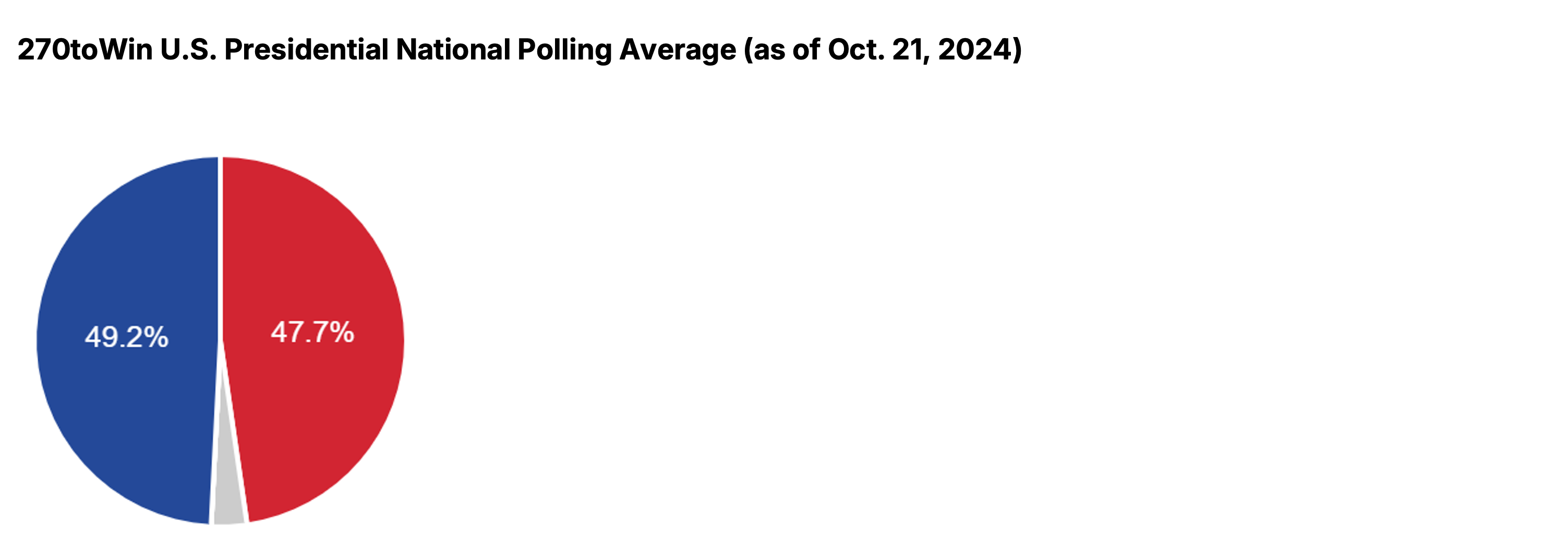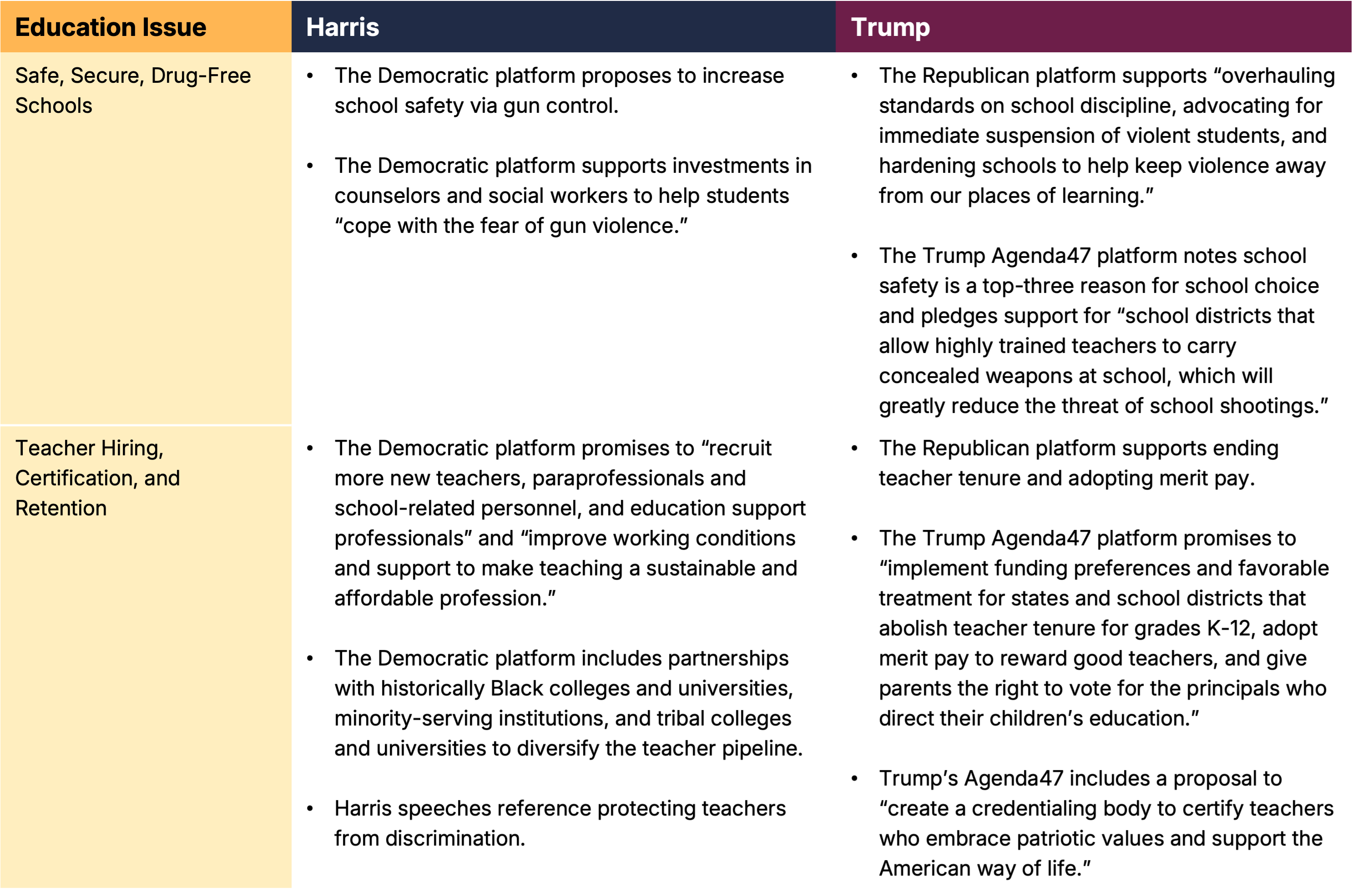OCTOBER 2024
Hidden in Plain Sight: How the 2024 Election Will Shape Federal Education Policy
Andrew J. Rotherham, Lynne Graziano, Sharmila Mann, Juliet Squire, and Andy Jacob
Introduction
How will the results of the 2024 election cycle affect federal education policy and education more generally? This analysis offers a best guess, based on the latest polling data and Bellwether research. Amid all the uncertainty in the final weeks of the campaign, and the lack of clarity from both presidential candidates on many issues, are some clear trends that will matter regardless of who wins.
Although education has not been a major campaign issue, educational attainment is an increasingly stark dividing line between Democrats and Republicans. Voters have clear opinions on what they would like to see leaders prioritize when it comes to schools. And beneath a long list of disagreements are some places Kamala Harris and Donald Trump seem to agree — ideas that could garner enough bipartisan support to see movement over the next two years.
Four Reasons Education Matters in This Election
Polls indicate that education is not a top issue for voters in the 2024 presidential election. When asked which issue is ”most important” to them, only 3% of voters selected education (as of Oct. 6, 2024).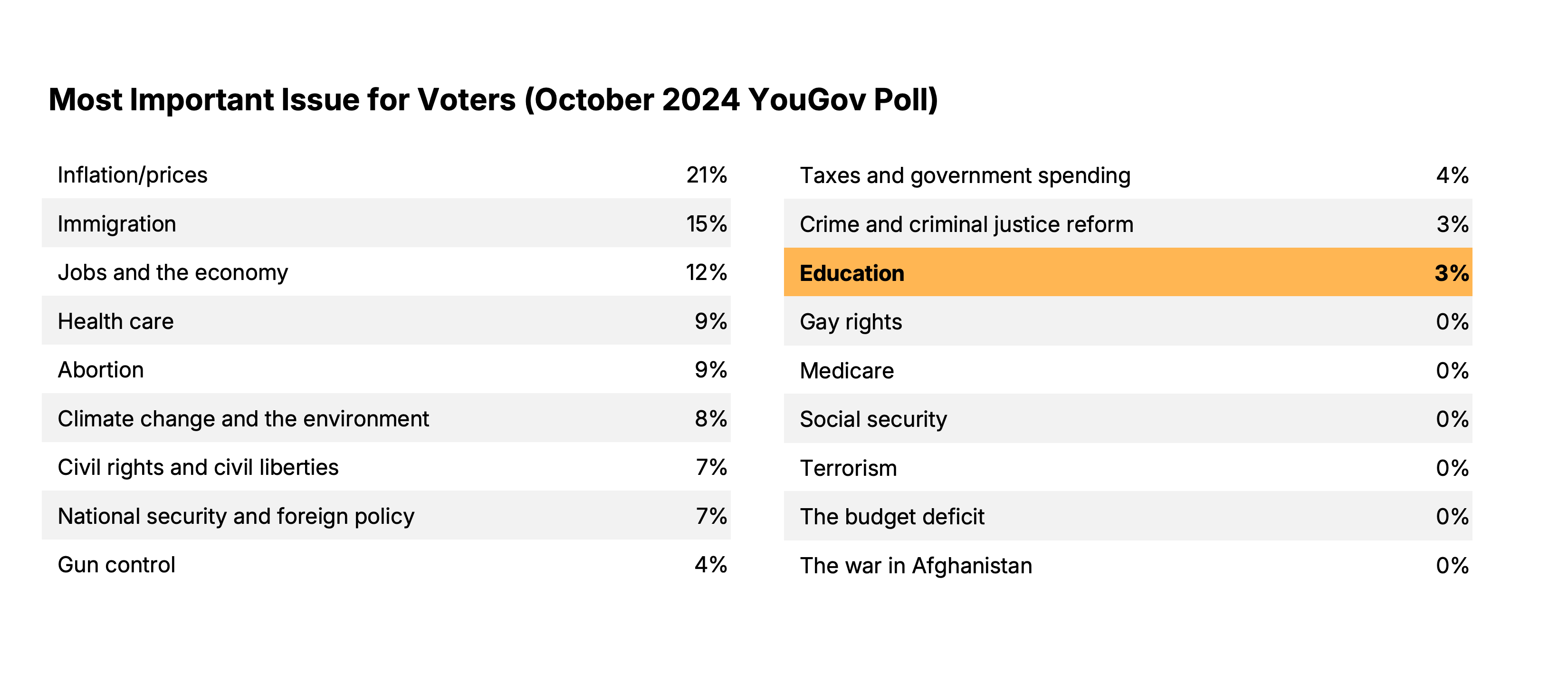
However, education does matter in this election cycle for four key reasons.
Reason #1: Educational attainment is driving shifts in the two parties’ coalitions.
Voters without a degree are trending from Democrat to Republican, while college graduates and advanced degree holders are trending Democratic. This is a notable trend over the past three presidential contests:
- Democratic share of non-college voters has declined from 51% in 2012 to 47% in 2020.
- Democratic share of college voters has increased from 52% in 2012 to 58% in 2020.
These trends are particularly pronounced within racial subgroups:
- Democratic share of white non-college voters has declined from 39% in 2012 to 36% in 2020.
- Democratic share of Black non-college voters has declined from 97% in 2012 to 90% in 2020.
- Democratic share of Latino non-college voters has declined from 70% in 2012 to 60% in 2020.

Reason #2: Voters (and especially parents) in both parties are concerned about education and agree on the issues the next administration should prioritize when it comes to schools.
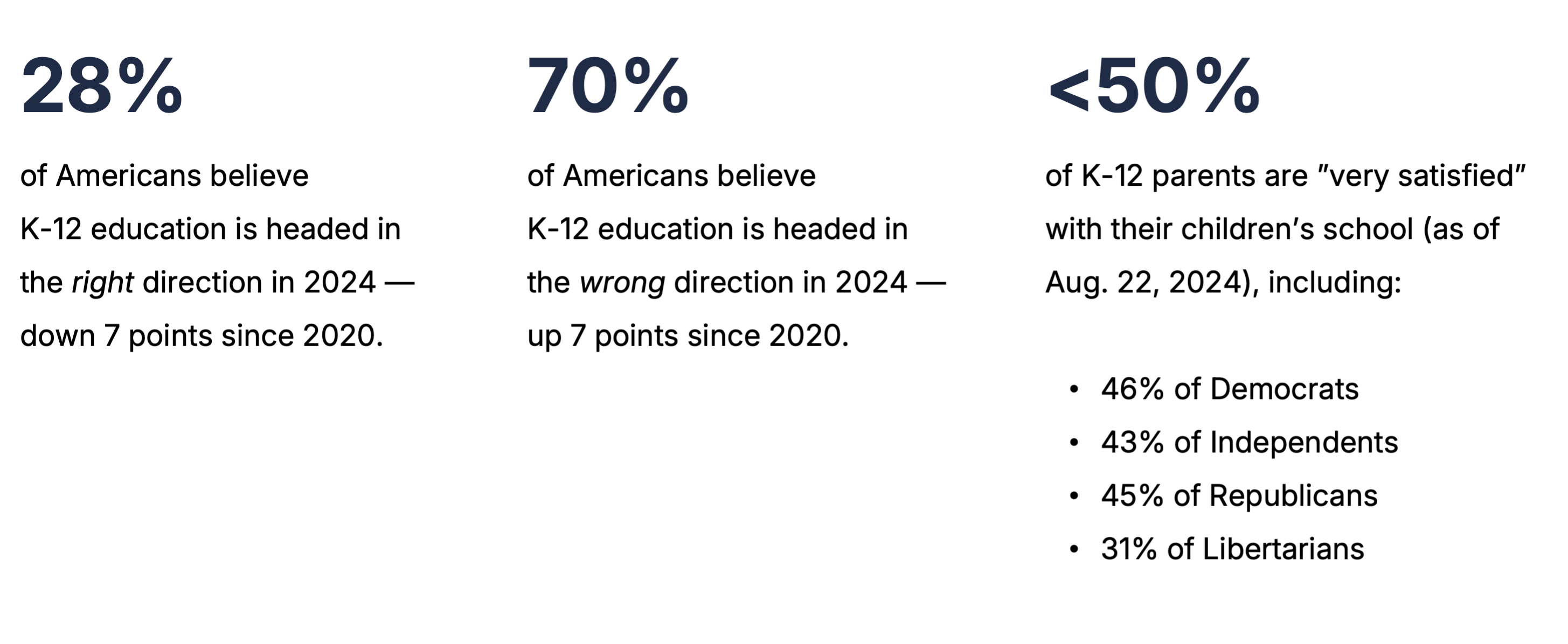
There are five education issues that more than half of Americans – across political parties – believe should be a focus of the next administration.
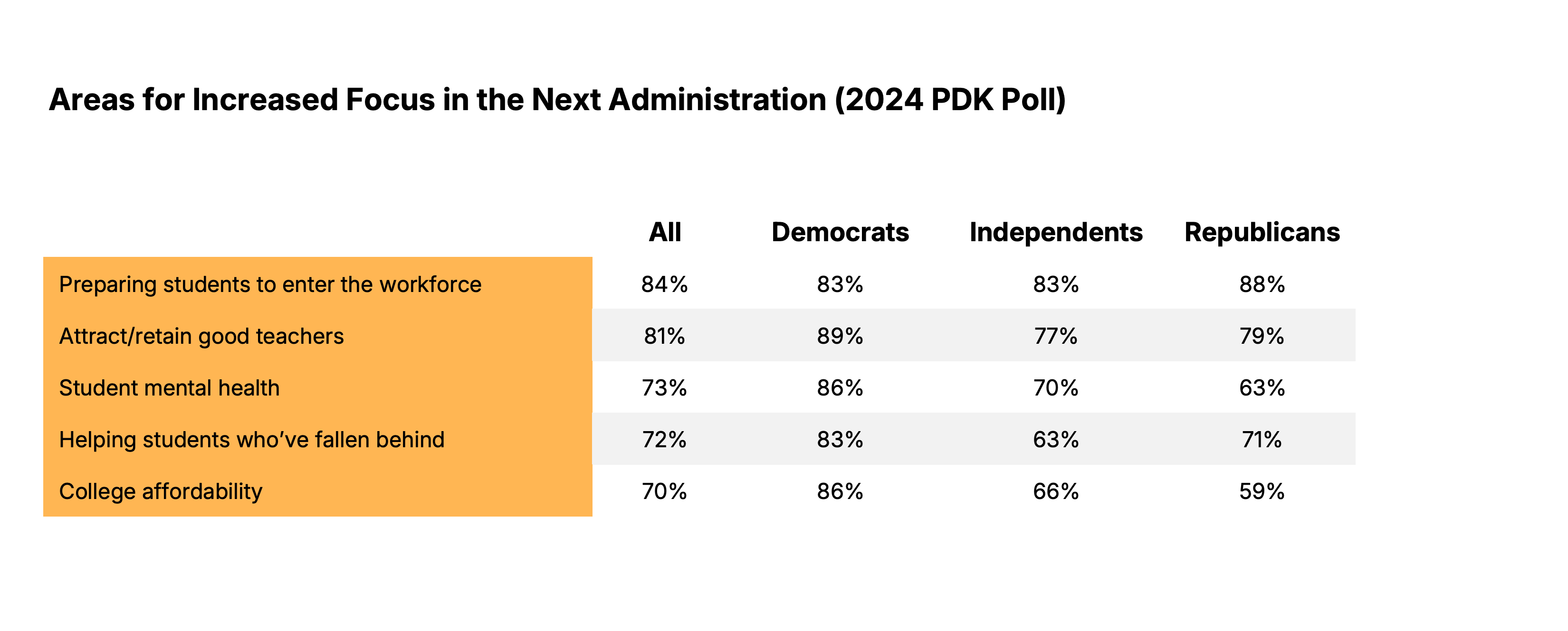
Reason #3: The election will affect whether and how the government addresses the challenges schools are facing.

End of COVID-19 Emergency Funding
The last round of Elementary and Secondary School Emergency Relief funding must be obligated by Sept. 30, 2024, and spent by Jan. 30, 2025. This marks the end of $122 billion in federal funding.

Declining Enrollment
Nationally, public school enrollment is down by about 1.2 million students since before the pandemic (2022 data), placing additional pressure on school budgets.

School Safety
The number of school shootings has increased since the pandemic, with 82 shootings in 2023. Meanwhile, 19% of students report being bullied during school and 46% of teens report experiencing cyberbullying.

Declining Literacy and Numeracy Skills; “Learning Loss”
Pandemic-era learning loss is reflected in 2022 scores on the National Assessment of Educational Progress, compared to 2019 scores, in which eighth-grade student proficiency rates dropped 8 percentage points in math (to 26%) and dropped 3 percentage points in reading (to 31%). Similar losses are also reflected in state assessments.

Student Mental Health
Among high school students in 2023, 40% reported feeling “so sad or hopeless almost every day for at least two weeks in a row that they stopped doing their usual activities.”
Reason #4: Many pieces of federal education legislation are overdue for reauthorization.
- The Every Student Succeeds Act, which provides money to K-12 schools for a variety of purposes, replaced No Child Left Behind as the most recent reauthorization of the Elementary and Secondary Education Act. It was last reauthorized in 2015.
- The Individuals with Disabilities Act focuses on the education rights of students with disabilities. Some provisions are permanent, but its last reauthorization was in 2004.
- The Higher Education Act, which provides funding to universities and loans to students, was last reauthorized in 2008.
- The Head Start Act, which focuses on early childhood education, was last reauthorized in 2007.
- The Strengthening Career and Technical Education for the 21st Century Act (colloquially known as “Perkins V”), which funds career and technical education programs, was last reauthorized in 2018.
- The Workforce Innovation and Opportunity Act, one of the primary pieces of federal legislation on workforce development, was last reauthorized in 2014.
- The Education Sciences Reform Act, which created the research arm of the U.S. Department of Education, was enacted in 2002 and has not been reauthorized since.
Congressional willingness to continue to appropriate funds without reauthorization has eased pressure to revisit numerous federal education statutes, including the Elementary and Secondary Education Act, the Individuals with Disabilities Act, and the Education Sciences Reform Act. However, these statutes are increasingly outdated and due for action.
Moreover, new provisions applicable to education have mostly passed as part of other issues, such as federal COVID-19 relief measures and investments in STEM education and workforce development as part of the Enhancing American Competitiveness Act of 2023.
Note: For more information on supporting data, see Sources.
A Close Election for President and Congress
With just days left in the campaign, this election is the closest in a generation and seems certain to produce a narrowly divided government no matter the exact result. The presidential race is effectively tied, and the margins in both the House and the Senate are shaping up to be small for whichever party controls them.
Kamala Harris has a slight lead over Donald Trump in national polling averages, but most swing states are essentially tied.
The 270toWin national polling average has Harris ahead by 1.5 points, which is within the margin of error and too close to call.
“With two weeks to go, the polls of the presidential election are starting to run out of room to get any closer.” —The New York Times
Republicans appear on track to win a narrow Senate majority, while the House is a toss-up.
Both the Senate and House elections are too close to call according to 270toWin. As of Oct. 21, 2024, prediction markets put the odds of a Republican trifecta (control of the White House and both chambers of Congress) at 46% and the odds of a Democratic trifecta at 12%.
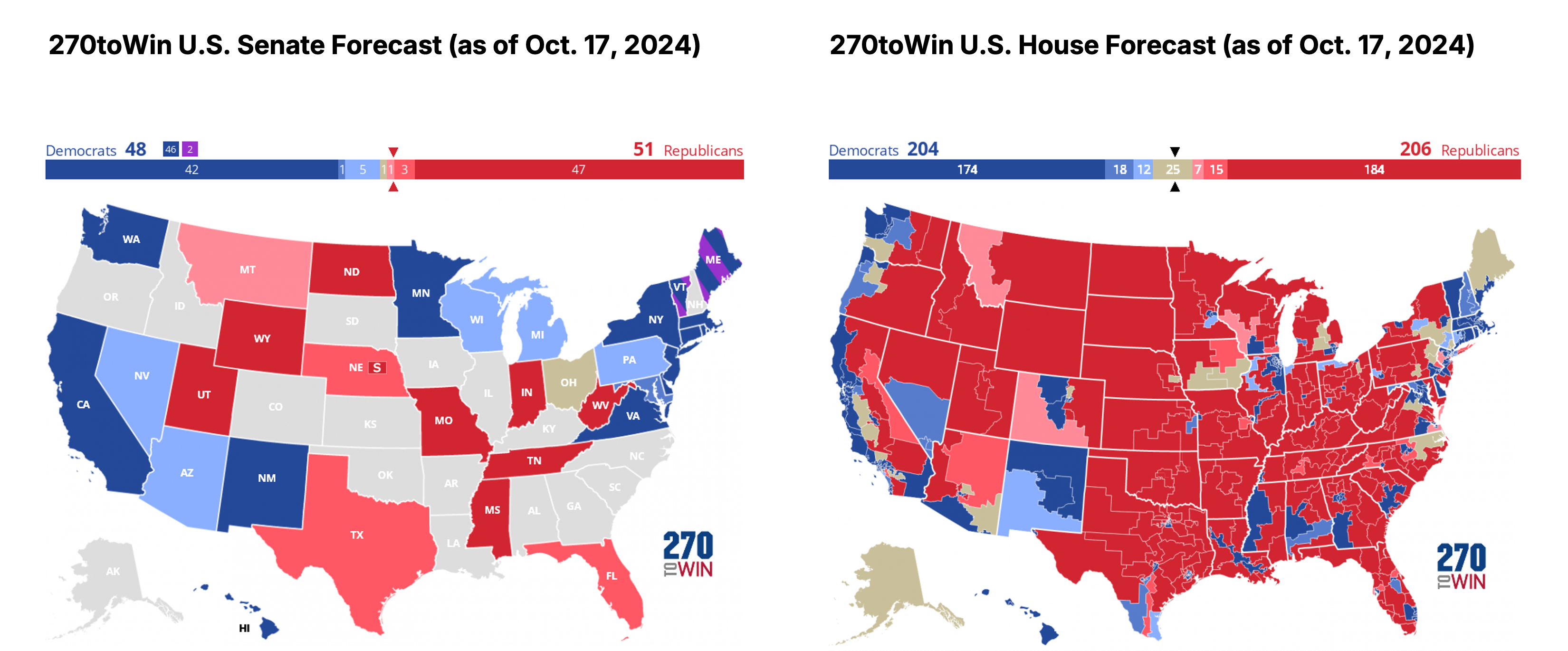
Note: For more information on supporting data, see Sources.
Which Education Policies Might Move Over the Next Two Years?
The election’s exact impact on education depends on which party wins the close races. But with narrow majorities expected in both houses of Congress, issues with at least some bipartisan agreement are much more likely to see meaningful action over the next two years (when the midterm elections may reshuffle the balance of power again).
While the two parties disagree on a lot when it comes to schools, partisan acrimony has obscured areas of agreement that are hiding in plain sight. To surface them, Bellwether analyzed the positions Kamala Harris and Donald Trump have staked out on education issues during their campaign speeches and in their party platforms. On issues where they have not taken clear positions this year, Bellwether looked at actions taken by the Biden and Trump administrations as imperfect but directionally useful substitutes.
This section presents issues where there is some level of agreement between the two candidates (indicated by green), as well as issues that both candidates have discussed frequently but where there is some or total disagreement on the solution (indicated by yellow and red). These issues are divided into two categories: those where the federal government can or must play a direct role, and those with less of a federal role but where the president could influence state or local policies through the bully pulpit.
Note: Neither presidential candidate has released detailed proposals on education issues, nor have they indicated their support or opposition to others’ detailed proposals. As a result, this analysis only considers issues where Bellwether could collect sufficient, directional information about candidates’ positions — judgment calls were made along the way based on limited information on issues the candidates have discussed.

On federal education policy, Harris and Trump agree on expanding postsecondary pathways.

Both Harris and Trump have addressed postsecondary pathways in their campaigns, voicing support for programs that provide work-based learning opportunities for students through programs like apprenticeships and internships — topics likely to resonate with non-college voters, who have trended increasingly toward the Republican Party in recent elections. With appropriations for Perkins V expiring in 2024 and recent efforts to reauthorize the Workforce Innovation and Opportunity Act, postsecondary pathways is a likely issue for legislative action under either a Harris or Trump administration.
Harris and Trump also support increasing the Child Tax Credit.

The Child Tax Credit was first enacted in 1997 and has been modified numerous times in the years since, including by the American Recovery and Reinvestment Act of 2009 and the American Rescue Plan Act of 2021. During the Trump administration, the Tax Cuts and Jobs Act of 2017 increased the Child Tax Credit and will expire at the end of 2025. During the Biden administration, the American Rescue Plan Act added further expansions to the Child Tax Credit, but those changes expired at the end of 2021.
Both candidates have indicated interest in expanding the Child Tax Credit, though the specific design of their expansion plans will vary in the amount of the tax credit and which families benefit.
Harris and Trump appear to have shared interests on other issues, but with different or unknown approaches. Neither have championed charter schools, meaning the best charter advocates might hope for is benign neglect from the federal government no matter who wins. Neither Trump nor Harris has directly addressed COVID-19 pandemic-related learning loss in their education proposals. Though they both supported emergency funding for schools during the Trump and Biden administrations — and though neither has shown great restraint on federal spending broadly in the past — their future interest in continuing support for academic recovery is unclear.
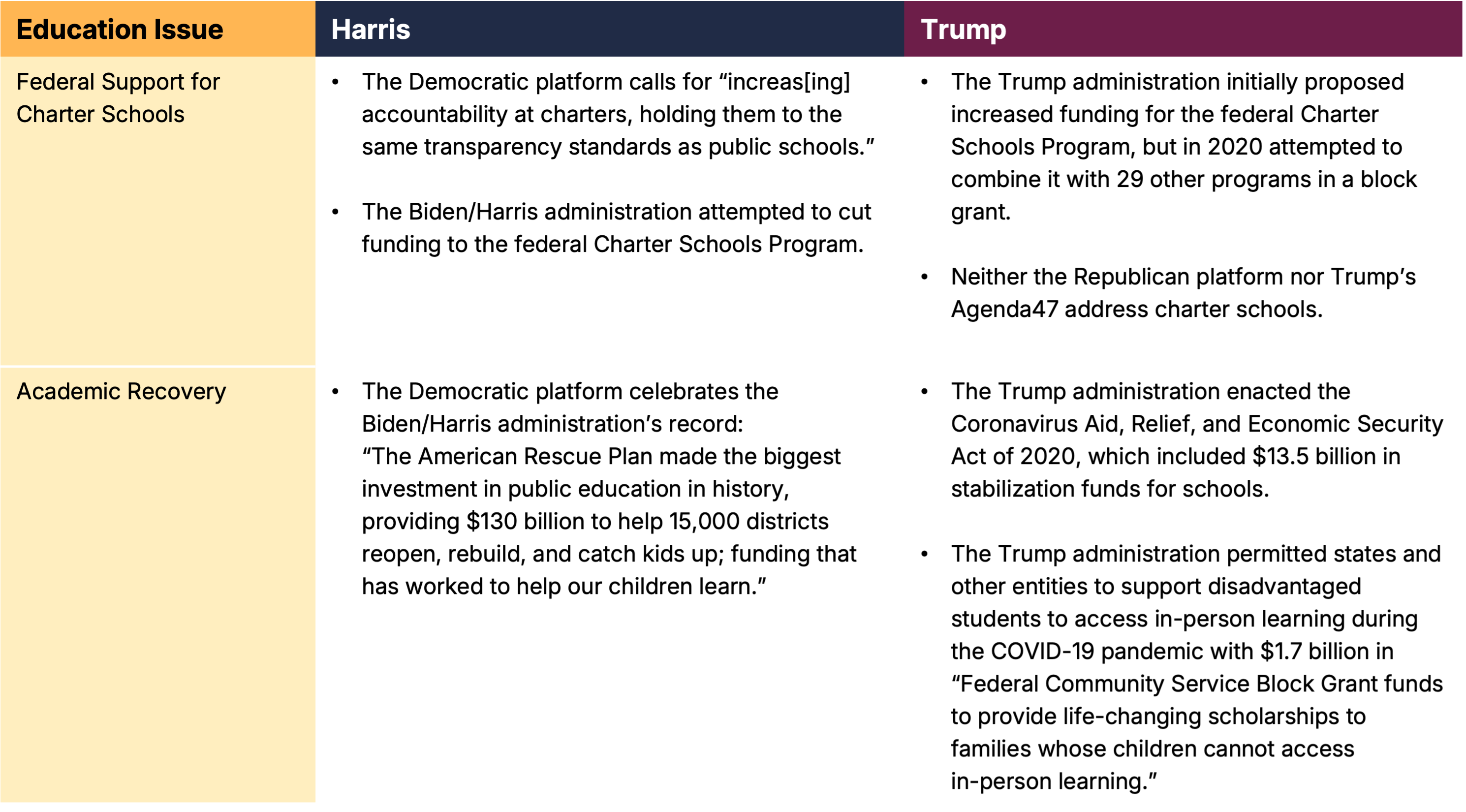
On federal education policy, Harris and Trump mostly disagree on school funding, student loan forgiveness, and Title IX issues.
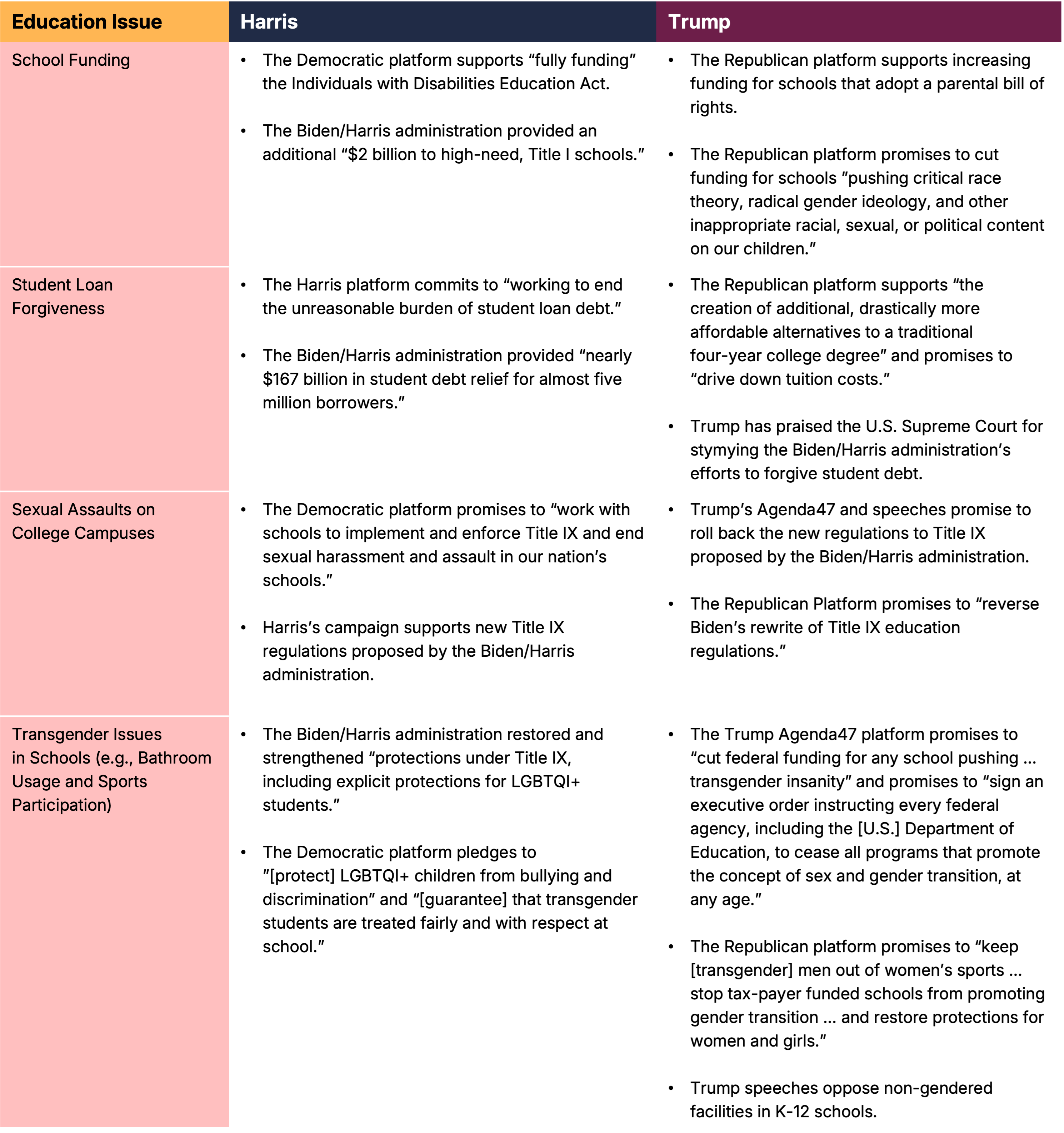
On state education policy, Harris and Trump have both focused on school safety and teacher/principal policies but have very different priorities on both.
On state education policy, Harris and Trump disagree most strongly on “culture war” issues and on private school choice.
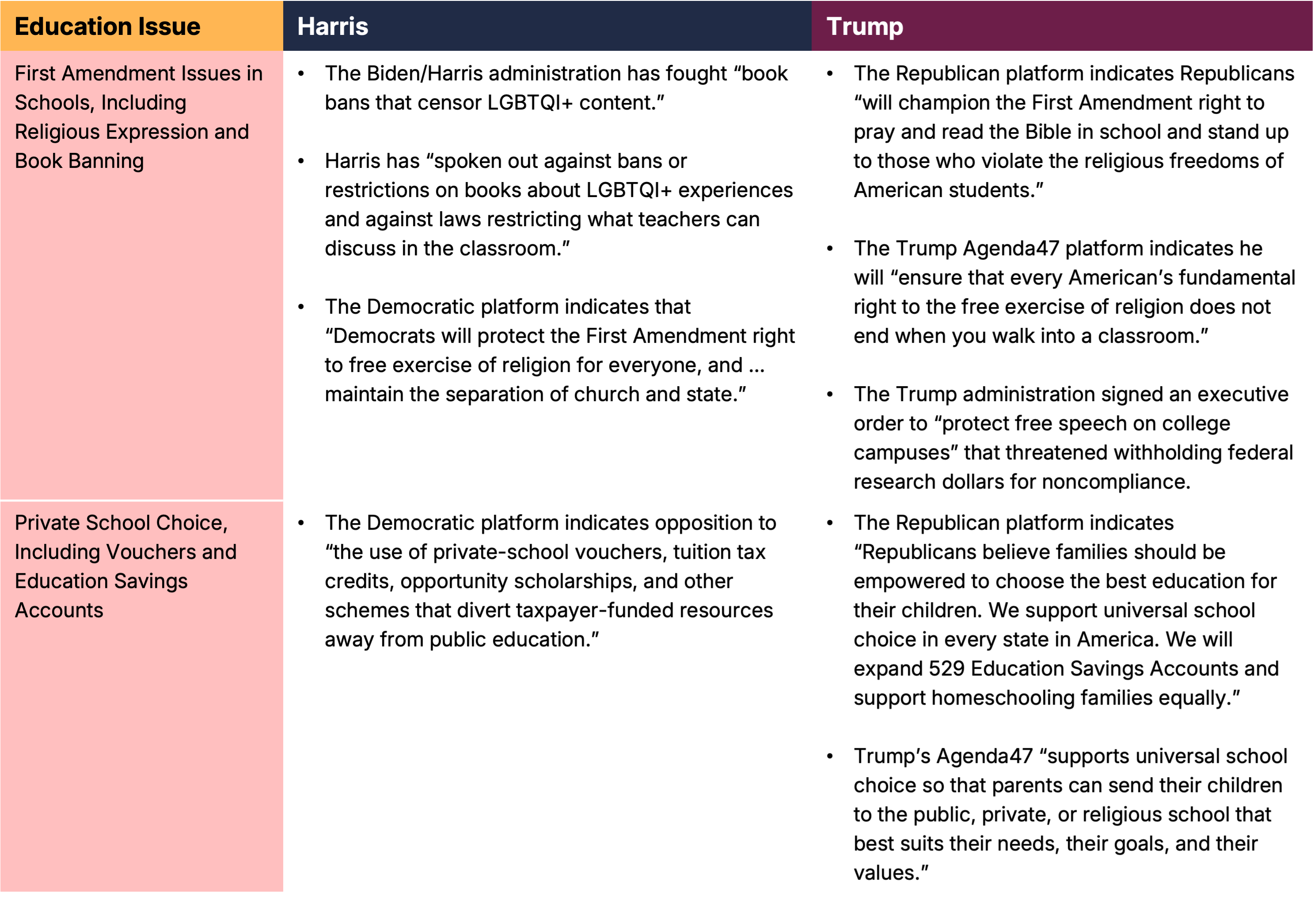
Note: For more information on supporting data, see Sources.
Other Things to Watch
The trends discussed will shape education policy over the next two years regardless of who wins the White House, House, or Senate. But the results of the election will help determine what happens, too. While this analysis cannot predict the future, it highlights a few things to watch for as the dust settles after Nov. 5.
White House
- Several education-related regulations and executive orders could become predictable “toggles” whenever the White House switches parties, including Title IX regulations on college campus sexual assault and executive actions on student loan forgiveness.
- Should Kamala Harris win the presidential election, she is likely to face cross-pressure within her own party on issues like federal funding for charter schools and Title IX regulations on transgender students’ participation in sports.
- Two recent U.S. Supreme Court decisions significantly weakened federal agencies’ regulatory power and opened the door for new challenges to long-established regulations. This will have an unpredictable and potentially significant impact on regulations on a range of issues, including education — and on future presidents’ power to make change by regulations alone.
Congress
- Recent history suggests that a narrow Democratic majority in the House could function more effectively than a narrow Republican majority — meaning Democrats would have a better chance at passing leaders’ priority legislation on a straight party-line vote. But whichever party controls the House can expect pressure from its flank (“The Squad” on the Democrats’ left and the “Freedom Caucus” on the Republicans’ right). In general, the left flank of the Democratic caucus has been less likely than the right flank of the Republican caucus to disrupt major legislation or the operations of the House.
- Without further changes to the filibuster rule in the Senate, budget reconciliation — limited to tax and spending provisions — offers the only realistic chance to pass anything but the most broadly bipartisan legislation.
Potential Congressional Leadership Changes
- Sen. Bill Cassidy (R – Louisiana), who will become chairman of the Senate education committee if Republicans capture a majority of that chamber, is generally well regarded in both parties and is not strongly aligned with Donald Trump (he was one of only seven Republican senators who voted to convict the former president in his second impeachment trial). Cassidy’s legislative priorities and areas of interest have included:
- Support for the Science of Reading.
- Addressing educational effects of the pandemic, including chronic absenteeism and student mental health.
- Concerns about social media and cell phone use in schools.
- Affordability of postsecondary education and accountability for antisemitism on college campuses.
- Rep. Hakeem Jeffries (D – New York 8th District), who will become Speaker of the House if Democrats win a majority in that chamber, has been a vocal supporter of charter schools — although less so since he became minority leader. His other legislative priorities and areas of interest have included:
- Expanding the Child Tax Credit.
- Protecting students from gun violence.
- Addressing student mental health challenges.
- Postsecondary readiness, including college affordability and expansion of career pathways programs.
Note: For more information on supporting data, see Sources.
Key State Races and Initiatives
Voters in some states will weigh in directly on education issues as they decide ballot initiatives and state superintendent races. Many of the hot topics in these races, such as school choice, illustrate the influence that national parties and the presidential bully pulpit can exert on state and local education policies.
In the states, there are several races and ballot initiatives with interesting education angles.
- School Choice: Colorado Amendment 80 would amend the state constitution to ensure that “each K-12 child has the right to school choice.”
- Provide Public Dollars for Private Schools: Kentucky Amendment 2 would allow the legislature to provide state funding to students outside of public schools.
- Block Public Grants for Private Schools: In Nebraska, a veto referendum seeks to overturn a bill authorizing a program to provide public grants to eligible students to attend private schools.
- Career and Technical Education Scholarships: In Arkansas, Issue 1 asks voters to support or oppose using proceeds from the state lottery to provide students with funding to access vocational-technical education.
- Graduation Requirements: Massachusetts Question 2 asks voters whether students should be required to achieve a certain competency level on the Massachusetts Comprehensive Assessment System exam to graduate high school.
- School Security and Safety: Colorado Proposition KK would apply a tax to the manufacturing and sale of firearms and ammunitions, with a portion of the proceeds going to support school security and safety programs.
- Bonds: In California, Proposition 2 would authorize bonds for public school and community college facilities; in New Mexico, a bond issue would provide $230 million to public higher education institutions, special public schools, and tribal schools.
- School Funding: Utah Amendment B would increase the limit on annual distributions from the State School Fund from 4% to 5%.
- School Board Elections: Florida Amendment 1 would be an amendment to the state constitution, making school board elections partisan starting in 2026.
- Superintendent Races: North Dakota Superintendent of Public Instruction Kirsten Baesler, a Republican, is running for her fourth consecutive term. She is the longest-tenured state superintendent nationwide. Republican candidate for state superintendent in North Carolina, Michele Morrow, defeated the current superintendent, Catherine Truitt, in the primary. Truitt is a former teacher; Morrow is a nurse who advocates for home-schooling.
Note: For more information on supporting data, see Sources.
Sources
The following sources were used in Bellwether’s analysis of the 2024 election cycle.
Four Reasons Education Matters in This Election
- “Most Important Issues Facing the US,” YouGov, https://today.yougov.com/topics/politics/trackers/most-important-issues-facing-the-us?period=3m. (As of October 6, 2024.)
- “2024 Presidential Vote Intent: Harris v. Trump,” YouGov, https://today.yougov.com/topics/politics/trackers/2024-presidential-vote-intent-harris-trump?crossBreak=white. (As of October 14, 2024.); “What Happened in 2022 National Crosstabs,” Catalist, May 18, 2023, https://www.dropbox.com/scl/fi/t7i2c2tgu7w84g08p6cim/Catalist_What_Happened_2022_Public_National_Crosstabs_2023_05_18.xlsx?dl=0&e=2&rlkey=rv64n9kk0cx4pcaf9hdd7wolg. (As of September 9, 2024.)
- “Schooling in America Survey Dashboard,” EdChoice, https://www.edchoice.org/what-we-do/research/schooling-in-america-polling-dashboard-2/; “Q1: School Satisfaction,” 50CAN Education Opportunity Survey, 2024, https://50can.org/wp-content/uploads/2024/10/Q1.SchoolSatisfaction.50CANEducationOpportunitySurvey.pdf.
- “2024 Poll Results,” PDK Poll, https://pdkpoll.org/2024-poll-results/. Survey was produced by Langer Research Associates for PDK International, with data collected June 21–July 1, 2024, in English and Spanish, among a representative, random national sample of 1,009 adults. Note the issue of school choice/vouchers was not polled in this survey.
- Mark Lieberman, “ESSER Is Ending. Which Investments Accomplished the Most?” Education Week, September 24, 2024, sec. Policy & Politics, Education Funding, https://www.edweek.org/policy-politics/esser-is-ending-which-investments-accomplished-the-most/2024/09; National Center for Education Statistics, “Public School Fall 2022 Enrollment Counts Remain Below Fall 2019,” The74, February 5, 2024, https://www.the74million.org/wp-content/uploads/2024/02/NCES-CCD-Press-Release_2024_02_05_2024.docx-1.pdf; Alex Matthews, Amy O’Kruk, and Annette Choi, “School Shootings in the US: Fast Facts,” CNN, September 2, 2023, https://www.cnn.com/us/school-shootings-fast-facts-dg/index.html; “Bullying,” The NCES Fast Facts Tool (National Center for Education Statistics), https://nces.ed.gov/fastfacts/display.asp?id=719; Katherine Schaeffer, “9 Facts about Bullying in the U.S.,” Pew Research Center (blog), November 17, 2023, https://www.pewresearch.org/short-reads/2023/11/17/9-facts-about-bullying-in-the-us/; “NAEP Reading: National Achievement-Level Results,” The Nation’s Report Card, 2022, https://www.nationsreportcard.gov/reading/nation/achievement/?grade=8; “NAEP Mathematics: National Achievement-Level Results,” The Nation’s Report Card, 2022, https://www.nationsreportcard.gov/mathematics/nation/achievement/?grade=8; Centers for Disease Control and Prevention, “Youth Risk Behavior Survey Data Summary & Trends Report: 2013-2023” (U.S. Department of Health and Human Services, 2024), https://www.cdc.gov/yrbs/dstr/pdf/YRBS-2023-Data-Summary-Trend-Report.pdf.
- “Title 1 – SEC. 1002. Authorization of Appropriations,” Every Student Succeeds Act (ESSA), https://www.everystudentsucceedsact.org/title-1–1; “About IDEA,” Individuals with Disabilities Education Act, https://sites.ed.gov/idea/about-idea/; “A History of the Individuals with Disabilities Education Act,” Individuals with Disabilities Education Act, https://sites.ed.gov/idea/IDEA-History/; “The Workforce Innovation and Opportunity Act: Supporting Efforts to Meet the Needs of Youth, Workers, and Employers,” The U.S. Senate Committee on Health, Education, Labor & Pensions, June 12, 2024, https://www.help.senate.gov/hearings/the-workforce-innovation-and-opportunity-act-supporting-efforts-to-meet-the-needs-of-youth-workers-and-employers; Katherine Knott, “Reforming Higher Education, One Bill at a Time,” Inside Higher Ed, November 9, 2023, https://www.insidehighered.com/news/government/student-aid-policy/2023/11/09/house-republicans-plan-series-bills-reform-higher-ed; “The College Cost Reduction Act: What You Need to Know,” American Council on Education, January 19, 2024, https://www.acenet.edu/News-Room/Pages/College-Cost-Reduction-Act.aspx; Katherine Knott, “House Democrats Counter Republicans’ Vision for Higher Ed Reform,” Inside Higher Ed, January 30, 2024, https://www.insidehighered.com/news/government/politics-elections/2024/01/30/house-democrats-share-roadmap-college-student-success; Steve Voytek, “Legislative Update: Congress Announces a Flurry of Education and Workforce Development Legislation,” Advance CTE Blog, December 8, 2023, https://blog.careertech.org/legislative-update-congress-announces-a-flurry-of-education-and-workforce-development-legislation/; Karen E. Lynch, “Head Start: Overview and Current Issues” (Congressional Research Service, December 5, 2019), https://crsreports.congress.gov/product/pdf/IF/IF11008; Kyrie E. Dragoo, “The Individuals with Disabilities Education Act (IDEA), Part B: Key Statutory and Regulatory Provisions” (Congressional Research Service, August 20, 2024), https://crsreports.congress.gov/product/pdf/R/R41833.
A Close Election for President and Congress
- Electoral vote map: “2024 Presidential Election Interactive Map,” 270toWin, 2024, https://www.270towin.com/maps/7Ner7. (As of October 21, 2024.); “2024 Presidential Election Polls: Harris vs. Trump,” 270toWin, 2024, https://www.270towin.com/2024-presidential-election-polls/; “Election 2024 Polls: Harris vs. Trump,” The New York Times, June 24, 2024, sec. U.S., https://www.nytimes.com/interactive/2024/us/elections/polls-president.html
- Sweep odds: “2024 Presidential Election Predictions,” Polymarket, 2024, https://polymarket.com/elections. Senate map: “2024 Senate Election,” 270toWin, 2024, https://www.270towin.com/2024-senate-election/ad1lld.png. (As of October 21, 2024.); House map: “Consensus 2024 House Forecast,” 270toWin, 2024, https://www.270towin.com/2024-house-election/consensus-2024-house-forecast. (As of October 21, 2024.)
Which Education Policies Might Move Over the Next Two Years?
Political Platforms (used for multiple issues)
- Harris platform: “Issues,” Kamala Harris for President: Official Campaign Website, https://kamalaharris.com/issues/.
- Harris Economic Policy Opportunity Book: “A New Way Forward for the Middle Class: A Plan to Lower Costs and Create an Opportunity Economy” (Harris Walz Campaign), https://kamalaharris.com/wp-content/uploads/2024/09/Policy_Book_Economic-Opportunity.pdf.
- DNC platform: “2024 Democratic Party Platform,” Education, https://democrats.org/wp-content/uploads/2024/09/2024_Democratic_Party_Platform_8a2cf8.pdf, 26–27.
- Trump Agenda 47 on Education: “Agenda47: President Trump’s Ten Principles for Great Schools Leading to Great Jobs,” Donald J. Trump for President 2024, September 13, 2023, https://www.donaldjtrump.com/agenda47/agenda47-president-trumps-ten-principles-for-great-schools-leading-to-great-jobs.
- RNC platform: “2024 GOP Platform,” Education, https://rncplatform.donaldjtrump.com/, 13.
- RNC platform: “2024 GOP Platform,” https://rncplatform.donaldjtrump.com/?_gl=1*1vvpae5*_gcl_aw*R0NMLjE3Mjk0NDIzNDUuQ2p3S0NBancxTks0QmhBd0Vpd0FWVUhQVUthWWJwZHh5cXVidGt2VTBVU3I1ZHdZMGZDQzJrNnZYczRCdk1ObGZfSFhOX3FQalloOGJSb0MtOEFRQXZEX0J3RQ..*_gcl_au*OTgyODAwODI4LjE3Mjk0NDIzNDU.&_ga=2.27586556.190467333.1730063394-858607712.1729442345&_gac=1.150613700.1729442345.CjwKCAjw1NK4BhAwEiwAVUHPUKaYbpdxyqubtkvU0USr5dwY0fCC2k6vXs4BvMNlf_HXN_qPjYh8bRoC-8AQAvD_BwE.
Career and Technical Education, Postsecondary Pathways
- Libby Stanford, “What the 2024 GOP Platform Says about K-12 and What It Would Mean If Trump Wins,” Education Week, July 10, 2024, https://www.edweek.org/policy-politics/what-the-2024-gop-platform-says-about-k-12-and-what-it-would-mean-if-trump-wins/2024/07.
- Sara Weissman, “Why Are Politicians Talking about Apprenticeships?” Inside Higher Ed, October 4, 2024, https://www.insidehighered.com/news/government/politics-elections/2024/10/04/why-politicians-are-talking-about-apprenticeships.
- “Executive Order Emphasizes Skills over Degrees for Federal Jobs,” https://www.shrm.org/topics-tools/news/talent-acquisition/executive-order-emphasizes-skills-degrees-federal-jobs.
- “A New Way Forward for the Middle Class: A Plan to Lower Costs and Create an Opportunity Economy.”
Child Tax Credit
- Kalyn Belsha, “Why Both Presidential Campaigns Are So Interested in Expanding the Child Tax Credit,” Chalkbeat, September 10, 2024, https://www.chalkbeat.org/2024/09/10/why-expanding-the-child-tax-credit-would-help-kids-at-school/.
- “A New Way Forward for the Middle Class: A Plan to Lower Costs and Create an Opportunity Economy.”
- “CARES Act Gives Extra $750 Million for Head Start Program,” Administration for Children & Families, June 4, 2020, https://www.acf.hhs.gov/media/press/2020/cares-act-gives-extra-750-million-head-start-program.
- Zeballos-Roig, “The 2025 Tax War Starts Early as Harris and Trump Vie over Child Credit.”
- Chuck Marr, Samantha Jacoby, and George Fenton, “The 2017 Trump Tax Law Was Skewed to the Rich, Expensive, and Failed to Deliver on Its Promises,” Center on Budget and Policy Priorities, June 13, 2024, https://www.cbpp.org/research/federal-tax/the-2017-trump-tax-law-was-skewed-to-the-rich-expensive-and-failed-to-deliver.
- “What Is the Tax Cuts and Jobs Act (TCJA)?” Tax Foundation, October 16, 2024, https://taxfoundation.org/taxedu/glossary/tax-cuts-and-jobs-act/.
- Aimee Picchi, “JD Vance Wants a $5,000 Child Tax Credit, or 150% More Than the Current CTC. Here’s What to Know,” CBS News, August 12, 2024, https://www.cbsnews.com/news/jd-vance-child-tax-credit-5000-what-to-know/
- “American Rescue Plan,” The White House, https://www.whitehouse.gov/american-rescue-plan/
- Margot L. Crandall-Hollick, “The Child Tax Credit: Legislative History” (Congressional Research Service, December 23, 2021), https://crsreports.congress.gov/product/pdf/R/R45124; Margot L. Crandall-Hollick, Brendan McDermott, and Conor F. Boyle, “Child Tax Credit: What Lies Ahead?” (Congressional Research Service, February 1, 2024), https://crsreports.congress.gov/product/pdf/IN/IN12297; “Remarks by Vice President Harris at a Campaign Event in Raleigh, NC,” The White House, August 16, 2024, https://www.whitehouse.gov/briefing-room/speeches-remarks/2024/08/16/remarks-by-vice-president-harris-at-a-campaign-event-in-raleigh-nc/; “Transcript: Sen. JD Vance on ‘Face the Nation with Margaret Brennan,’ Aug. 11, 2024,” CBS News, August 11, 2024, https://www.cbsnews.com/news/transcript-jd-vance-on-face-the-nation-aug-11-2024/; Joseph Zeballos-Roig, “The 2025 Tax War Starts Early as Harris and Trump Vie over Child Credit,” Semafor, August 16, 2024, https://www.semafor.com/article/08/16/2024/the-2025-tax-war-starts-early-as-harris-and-trump-vie-over-child-credit.
Academic Recovery
- “President Donald J. Trump Is Expanding Educational Opportunity for America’s Children and Families Impacted by the Pandemic,” Trump White House Archives, December 28, 2020, https://trumpwhitehouse.archives.gov/briefings-statements/president-donald-j-trump-expanding-educational-opportunity-americas-children-families-impacted-pandemic/.
- Mitch McConnell, “Text – S.3548 – 116th Congress (2019-2020): CARES Act,” legislation, June 3, 2020, https://www.congress.gov/bill/116th-congress/senate-bill/3548/text.
Universal Pre-K and Head Start
- “CARES Act Gives Extra $750 million for Head Start Program.”
- “Why Both Presidential Campaigns Are So Interested in Expanding the Child Tax Credit.”
School Funding
- Shauneen Miranda, “Education: Where Do Harris and Trump Stand?” Louisiana Illuminator, October 3, 2024, https://lailluminator.com/2024/10/03/education-harris-trump/.
- “American Rescue Plan.”
- McConnell, “Text – S.3548 – 116th Congress (2019-2020): CARES Act.”
Charter Schools
- “President Donald J. Trump Is Expanding Educational Opportunity for America’s Children and Families Impacted by the Pandemic.”
- Patrick Gleason, “Harris’s Rejection of School Choice Contradicts Opportunity Rhetoric,” Forbes, September 25, 2024, https://www.forbes.com/sites/patrickgleason/2024/09/25/harriss-rejection-of-school-choice-contradicts-opportunity-rhetoric/.
- “President Biden’s FY2025 Budget Proposes Historic Cut to Federal Charter Schools Program,” National Alliance for Public Charter Schools, March 11, 2024, https://publiccharters.org/news/statement-2025-presidential-budget/.
- Matt Barnum and Kalyn Belsha, “The Trump Administration Wants to Cut Money for Charter School Growth,” Chalkbeat, February 10, 2020, https://www.chalkbeat.org/2020/2/10/21178580/the-trump-administration-wants-to-cut-federal-education-spending-including-money-for-charter-schools/.
Student Loan Forgiveness and Financial Aid
- Mark J. Drozdowski, “Trump Proposes Free Online National University,” BestColleges, November 9, 2023, https://www.bestcolleges.com/news/analysis/trump-proposes-free-online-national-university/.
- “President Donald J. Trump Is Expanding Educational Opportunity for America’s Children and Families Impacted by the Pandemic.”
- LIVE: Kamala Harris Speaks to Teachers in Texas, 2024, https://www.youtube.com/watch?v=tSkO1vhQusI.
- Adam S. Minsky, “Trump Slams Biden’s Student Loan Forgiveness Plans, Suggests Reversal,” Forbes, June 20, 2024, https://www.forbes.com/sites/adamminsky/2024/06/20/trump-knocks-bidens-vile-student-loan-forgiveness-plans-suggests-reversal/.
- “FACT SHEET: Biden-Harris Administration Announces Record Over $16 Billion in Support for Historically Black Colleges and Universities (HBCUs),” The White House, May 16, 2024, https://www.whitehouse.gov/briefing-room/statements-releases/2024/05/16/fact-sheet-biden-harris-administration-announces-record-over-16-billion-in-support-for-historically-black-colleges-and-universities-hbcus/; “Harris vs. Trump on Student Loans, Education: Where They Stand,” Washington Post, September 10, 2024, https://www.washingtonpost.com/politics/interactive/2024/trump-harris-student-loans-education/; Benjamin Collins, Milan N. Ball, Joselynn H. Fountain, and Cassandria Dortch, “The FUTURE Act (P.L. 116-91): Amendments to the Higher Education Act and Internal Revenue Code” (Congressional Research Service, June 9, 2020), https://www.everycrsreport.com/files/2020-06-09_R46400_32521c8d6f340306b0ea7cba214cf46cd0a26f56.pdf.
Title IX
- Matthew Arrojas, “Kamala Harris Higher Education Policy Views,” BestColleges, September 18, 2024, https://www.bestcolleges.com/news/kamala-harris-education-policy/.
Teachers, Principal Hiring, Certification, and Retention
- LIVE: Kamala Harris Speaks to Teachers in Texas.
First Amendment
- Jacob Sullum, “Neither Harris nor Trump Is a Friend of Free Speech,” Reason, October 9, 2024, https://reason.com/2024/10/09/neither-harris-nor-trump-is-a-friend-of-free-speech/.
- “Kamala Harris’s Education Policies, Explained,” Washington Post, September 10, 2024, https://www.washingtonpost.com/politics/interactive/2023/presidential-candidates-2024-policies-issues/kamala-harris-student-loans-education/.
- Andrew Albanese and Steve Zalusky, “The Week in Libraries: July 26, 2024,” Publishers Weekly, July 26, 2024, https://www.publishersweekly.com/pw/by-topic/industry-news/libraries/article/95586-the-week-in-libraries-july-26-2024.html.
- “Remarks by President Trump at Signing of Executive Order, ‘Improving Free Inquiry, Transparency, and Accountability at Colleges and Universities,’” Trump White House Archives, March 21, 2019, https://trumpwhitehouse.archives.gov/briefings-statements/remarks-president-trump-signing-executive-order-improving-free-inquiry-transparency-accountability-colleges-universities/.
- Maegan Vazquez and Betsy Klein, “Trump Signs Executive Order on Campus Free Speech,” CNN, March 21, 2019, https://www.cnn.com/2019/03/21/politics/campus-free-speech-executive-order-donald-trump/index.html.
Other Things to Watch
- Amy Howe, “Supreme Court strikes down Chevron, curtailing power of federal agencies,” SCOTUSblog, June 28, 2024, https://www.scotusblog.com/2024/06/supreme-court-strikes-down-chevron-curtailing-power-of-federal-agencies/.
- Amy Howe, “Supreme Court expands time frame to sue federal agencies,” SCOTUSblog, July 2, 2024, https://www.scotusblog.com/2024/07/supreme-court-expands-time-frame-to-sue-federal-agencies/.
Key State Races and Initiatives
- “2024 Ballot Measures,” Ballotpedia, October 2024, https://ballotpedia.org/2024_ballot_measures; Libby Stanford, “The Surprising Contenders for State Superintendent Offices This Year,” Education Week, June 17, 2024, https://www.edweek.org/policy-politics/the-surprising-contenders-for-state-superintendent-offices-this-year/2024/06.
Acknowledgments, About the Authors, About Bellwether
Acknowledgments
We would like to thank our Bellwether colleague Stephanie Escobar Thon for her support. Thank you also to Amy Ribock, Kate Neifeld, Andy Jacob, Zoe Cuddy, Julie Nguyen, Mandy Berman, and Amber Walker for shepherding and disseminating this work, and to Super Copy Editors.
The contributions of these individuals and entities significantly enhanced our work; however, any errors in fact or analysis remain the responsibility of the authors.
About the Authors

Andrew J. Rotherham
Andrew J. Rotherham is a co-founder and senior partner at Bellwether. He can be reached at andy@bellwether.org.

Lynne Graziano
Lynne Graziano is a senior analyst at Bellwether in the Policy and Evaluation practice area. She can be reached at lynne.graziano@bellwether.org.

Sharmila Mann
Sharmila Mann is an associate partner at Bellwether in the Policy and Evaluation practice area. She can be reached at sharmila.mann@bellwether.org.

Juliet Squire
Juliet Squire is a senior partner at Bellwether in the Policy and Evaluation practice area. She can be reached at juliet.squire@bellwether.org.

Andy Jacob
Andy Jacob is the senior director and External Relations team leader at Bellwether in the External Relations team. He can be reached at andy.jacob@bellwether.org.

Bellwether is a national nonprofit that exists to transform education to ensure systemically marginalized young people achieve outcomes that lead to fulfilling lives and flourishing communities. Founded in 2010, we work hand in hand with education leaders and organizations to accelerate their impact, inform and influence policy and program design, and share what we learn along the way. For more, visit bellwether.org.


